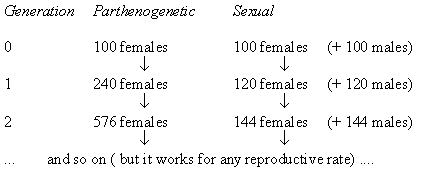that there is, theoretically, at least, a Two-fold cost of sex. Populations should grow faster if they consists purely of
parthenogens rather than having a 1:1 sex ratio. Suppose each female produces 2.4 progeny:

We have discussed ovaries and testicles as primary sex organs, directly involved in the production of gametes. We have also mentioned (and will cover in more detail next time) the organs involved in gamete transfer and embryo incubation in our own species.
"Sexual dimorphism: The difference in the appearance and morphology
of males and females. For example, males may be
either larger (as in primates) or smaller (as in hawks) than females.
Sexual selection: The tendency for one sex (usually females) to prefer
individuals of the other sex which express a certain
character to a greater degree. The expression of this character is
presumably associated with greater reproductive success in
the parents, which would be inherited by the offspring. Sexual selection
tends to lead to sexual dimorphism"
The above definitions can be found at:
http://www.nau.edu/biology/gloss1.html#dimo
We are a sexually dimorphic species. In class I will show some extreme and not so extreme examples of secondary sex characteristics and sexual dimorphism in other species.
Consider this quote from
http://www.ucl.ac.uk/~ucbhdjm/courses/b242/Sex/Sex.html
an online course about sex and sexual selection.
"EVOLUTION OF SEX
Costs of sex
Recombination and sex is often a complicated energy-requiring process,
which may expose the organisms having it to
increased predation and other dangers (even if it is fun).
One of these costs seems particularly severe: letís think about the
costs of sex to dioecious organisms. It turns out
that there is, theoretically, at least, a Two-fold cost of sex.
Populations should grow faster if they consists purely of
parthenogens rather than having a 1:1 sex ratio. Suppose each female
produces 2.4 progeny:

Males contribute little but genes to the population, but suck off
nutrients from the females; clearly males are useless! In
a population like this, parthenogens will quickly outdo sexual females
and will have a higher and higher frequency in the
population. In fact, the advantage will not always be twofold, because
some males do do useful things, like parental
care, nuptial feeding, and so on rather than just standing around
looking pretty. But it is hard to imagine that males are
not a load at all in these kinds of populations!
If there are such strong disadvantages to dioecy (separate sexes),
to say nothing of the cost and danger of meiosis and other forms ofsexual
liaisons, there must be some pretty hefty advantages too.We have argued
that recombination seems to be perhaps the primary feature found in all
examples of sex. So the advantages of sex must have something to do with
recombination. "
http://www.ucl.ac.uk/~ucbhdjm/courses/b242/Sex/Sex.html
In fact, studies have shown that the parthenogenic lizards we discussed last time do produce more offspring than closely related sexually reproducing species.
Throughout the animal kingdom females and males are often easy to distinguish visually. This, presumably, helps ensure that opposites find one another. In species that do not have visibly distinct females and males, behavioral cues are often used. In species that release eggs and sperm in a broadcast manner, such as sea urchins. These visual and behavioral cues are considered costly, both in terms of energetics and loss of life. A brilliantly colored male cardinal is more visible to predators than the duller red female. Yet these types of distinct appearances and behaviors have evolved many times in many species.
The costly nature of sexual dimorphism has lead to
the analysis that males seek or advertise for mates and females make choices
between more or less "attractive" potential partners. This
analysis dates back to Charles Darwin.
There are lots of ways of looking at this (a more detailed description
can be found in the uk web site above).
Females have an innate sensory bias, and males simply exploit this (I can show you an example from fish).
Females benefit directly from choosing a larger, or healthier male or one with a large territory (more potential for food and nest sites). Certainly there are many examples of "succesful males" mating more often or to the exclusion of other males (I'll show you one), but these studies as misleading, because in many mammalian populations, primates in particular, the "non-dominant" males do mate, and any particular individual will not be "dominant" for a lifetime.
Females benefit indirectly from the "valuable" inherited traits that are passed on to their offspring, or the "sexy sons" hypothesis, (which seems a bit androcentric to me, aren't daughters affected as well?), or the "good genes" hypothesis. In the "sexy sons" hypothesis the female mating with an extreme male ensures that her offspring will carry the genes for the extreme male traits as well as the female preference for those traits. In the good genes hypothesis, females select males that have "exaggerated costly" traits because they are healthy and "fit" for the environment. An example of this is swallow's tails, which in the male are shorter if the nest has been infected by mites. In two sorts of studies, females did prefer mail with longer tails, perhaps because they were healthier, but the preference was exhibited even if the tails were artificially shortened. Some authors have suggested that there is also selection for "non-cheatable" traits, in other words characteristics that have a higher genetic component and a lower environmental one. Thus position of feathers might be non-cheatable whereas the pigmentation of the feathers, which could be influenced by diet is a "cheatable" characteristic.
What if any of this applies to our species?